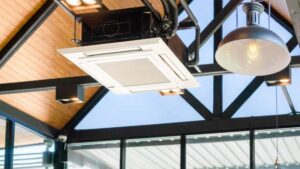Reverse cycle ducted air conditioners provide year-round comfort. They heat your home in winter and cool it in summer by extracting outdoor heat and reversing the process.
They can also be fitted with zoning, allowing you to choose what temperature each room should be at at any given time. This eliminates arguments over thermostat settings and saves energy.
Cost
 When choosing reverse cycle air conditioning, you must consider the upfront and running costs. Ducted air conditioning Mandurah systems offer heating and cooling functionality unlike split system units. This means you’ll only have to use the heater in winter, while you can enjoy a cool breeze throughout summer.
When choosing reverse cycle air conditioning, you must consider the upfront and running costs. Ducted air conditioning Mandurah systems offer heating and cooling functionality unlike split system units. This means you’ll only have to use the heater in winter, while you can enjoy a cool breeze throughout summer.
Ducted systems are more expensive to purchase and install than split systems. However, they provide whole-home heating and cooling from one unit, which can be controlled via a single central thermostat. The cost of a ducted system can vary depending on the size of your home, the number of zones and other factors. Whether building from scratch or renovating, it’s important to work the cost of a ducted air conditioning system into your plans.
Ideally, you should get at least three quotes from experienced and reliable installers to find the best price. Ask for references from previous clients and look for online reviews. You should also check the installer’s licence and insurance coverage to ensure they can complete the job. Ask the installer to inspect your property before providing a quote. This will help them determine if they can install a ducted air conditioning system in your home. If not, they may recommend a split system.
Energy Efficiency
Reverse cycle ducted air conditioners work to cool homes during summer and warm them in winter. They do this by extracting heat from the outdoor air and transferring it indoors during winter, then reversing the process to cool the home in summer. This makes them more versatile than standard air conditioning systems, and it also means they are more energy efficient than heating or cooling alone.
The reverse cycle air conditioning will use a central unit that distributes heat or air throughout the building through a network of insulated ducts. These systems are ideal for larger buildings that can heat and cool rooms evenly, quickly and efficiently.
When a ducted system is set to cooling mode, the fan draws heated air over a refrigerant that absorbs the heat and then cools the air, releasing it back into the room. The cooled air is then distributed throughout the house through vents located in ceilings or walls.
The heating process differs slightly from the cooling mode, as the indoor unit converts into a condenser and pumps the heat out through a vent. The condenser can then absorb the heat from outside and pump it into the house to keep you warm and cosy.
Ducted systems can be enhanced with zoning, allowing you to control each zone’s temperature. This can save you money by allowing you to heat or cool only the areas of the house you are using. This is significantly more energy efficient than a non-zoning system, which must run constantly to keep the whole house at an optimal temperature.
Safety
Reverse cycle ducted air conditioners are perfect for cooling your home during summer and heating it during winter. They use a central unit installed in the roof cavity, with ducts leading to each room of your home or office. These systems are available with zoning so you can control the temperature of individual rooms.
The heat pump in a reverse cycle system uses refrigerant to move energy around the home. Refrigerant is a special chemical that can easily change from liquid to gas and back again. This state switching allows it to absorb and move thermal energy (heat). The system also uses a compressor, condenser, and evaporator.
The reverse cycle air conditioning is preferred in arid climates and can be used in new buildings, renovations, and double-storey homes. They are more expensive to install and operate than split air conditioning units, but they provide better comfort and energy efficiency. They also have a higher resale value.
The return air grilles or ceiling vents are usually located in the roof space, making them less visually intrusive than other types of air conditioning. They can be fitted with a Ford & Doonan clean air filter pack, providing superior filtration. This means lower dust and other pollutants in your home. However, if the ducts get dirty, it can cause restricted flow and decreased air quality. This can lead to eye and nasal allergies and increase your power bills.